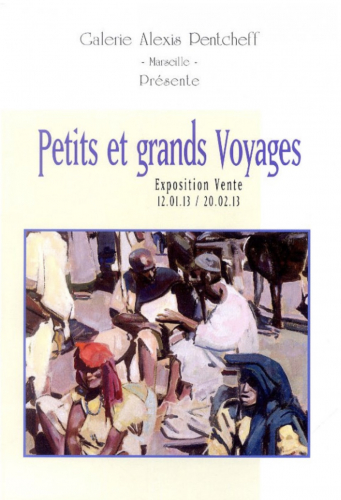From January 12, 2013
to February 21, 2013
This exhibition devoted to travel brought together more than 150 works by some thirty French artists from the 19th and 20th centuries who traveled outside their own borders: to Italy, Spain, North Africa and Asia. Provençal and from elsewhere, it was from Marseille that men in search of adventure embarked for the Orient, near or far. It was here, finally, that they disembarked on their return journey. So many departing artists have indeed passed through Marseille, their minds lulled by fantasies on the eve of setting sail and, sometimes many years later, their eyes full of memories as they approached its shores. It is therefore quite natural that the theme of travel inspired our first exhibition of 2013, which saw the consecration of Marseille as European Capital of Culture.
Since the 17th century, the port of Marseille has played a particularly important role on an international scale. In 1669, an ordinance by Colbert granted the city a monopoly on trade with the Orient by creating a free port. The Chamber of Commerce enjoyed a special status and became the hub of all operations there, regulating the settlement of all French subjects in the Levant. From the 18th century onwards, these commercial exchanges intensified and travel began to be less uncertain.
The following century marked the beginning of colonization, further reinforcing the role played by Marseille as the "gateway to the Orient". Cultural exchanges were to give rise to lasting commercial exchanges. The whole of Europe turned towards this fascinating and mysterious Orient, and all the artistic branches were influenced by it, particularly painting. After Turkey, Egypt and the Maghreb shared the infatuation of Europeans. A little later, much further away, the Far East reveals other charms. Indochina was a new land of welcome, just as mysterious and bewitching.
In the 20th century, Marseilles remained at the heart of the colonial empire, so much so that it managed to wrest from Paris the organization of two international events that consecrated its influence: the colonial exhibitions of 1906 and 1922. Between April and November 1906, the first of the two events attracted nearly 1,800,000 visitors, who no longer knew where to look. But already the foundations of this imperialist society and what it represented were beginning to crack, and the 1922 exhibition was marked by numerous anti-colonialist demonstrations.
But it is not only towards the sea that Marseille proposes to escape. It is also located by land at a strategic geographical point, in the heart of southern Europe, closer by road to Italy and Spain than to the capital of Paris.
Through the sensitivity of some thirty artists of the 19th and 20th centuries, whether they were occasional travelers or true "globe-trotters", whether they delivered the fleeting impression of a place only glimpsed or the clearer image of one who has already penetrated it, we offer visions as singular as they are inspired.
Artists presented : Louis Antoni, Adolphe Bachmann, Marcel Blairat, Charles Calderon, Alexandre Caminade, Léon Canniccioni, François Corbellini, Vincent Courdouan, Frédéric Dufaux, Georges d'Espagnat, Antoine Gadan, André Hambourg, Emile Henry, Jean-Baptiste Huysmans, Joseph Inguimberty, Gustave Lino, Olynthe Madrigali, André Maire, Jacques Majorelle, Albert Marquet, Paul Pascal, Antoine and Jos-Henri Ponchin, Marius Reynaud, Georges Rochegrosse, Georges Serré, Félix Ziem. ..

